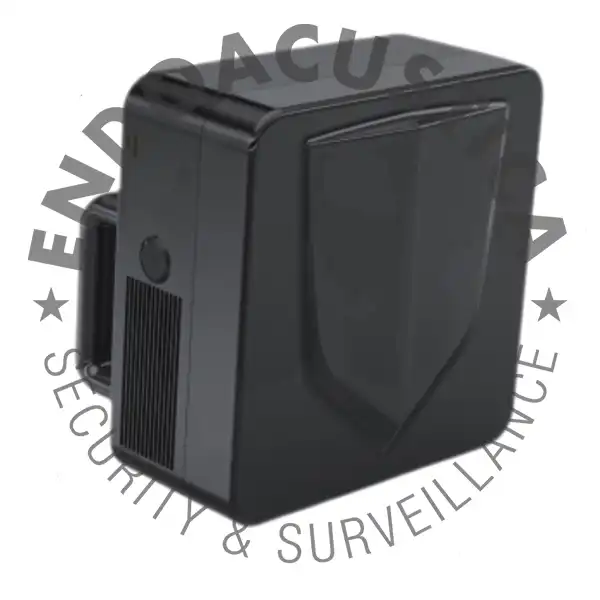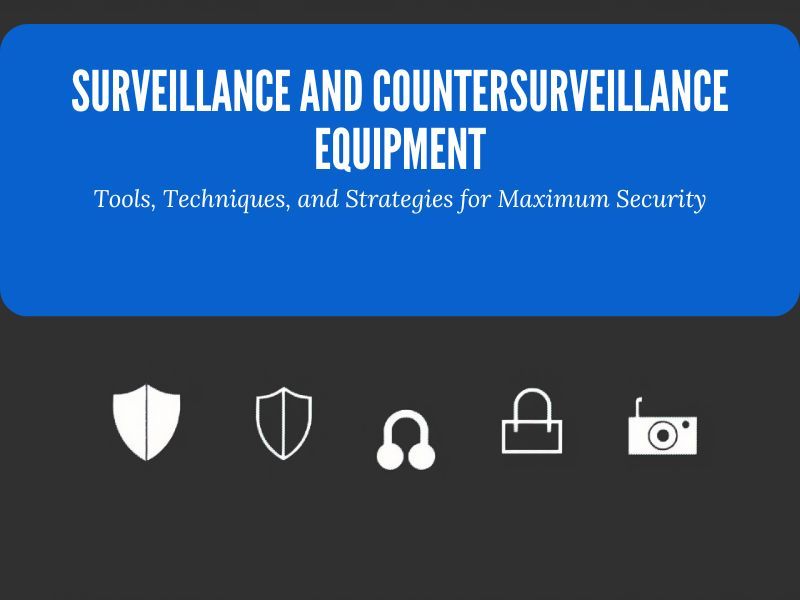In an age where privacy is increasingly under threat—from corporate data mining to state surveillance and personal stalking—the need for robust surveillance and countersurveillance equipment has never been greater. Whether you're a high-profile individual, business executive, journalist, or simply a privacy-conscious citizen, understanding the tools and tactics of both surveillance and counter-surveillance is essential.
This comprehensive guide explores everything you need to know about surveillance and countersurveillance equipment , including their types, uses, legal considerations, and how to choose the best tools for your specific needs. We’ll also delve into the evolving technologies shaping this field and provide expert recommendations based on performance, reliability, and real-world application.
What Is Surveillance?
Surveillance refers to the act of monitoring individuals, places, or activities to gather information or ensure security. It can be conducted by governments, law enforcement agencies, private investigators, businesses, or even individuals.
Common Forms of Surveillance Include:
- CCTV (Closed Circuit Television)
- GPS tracking
- Audio recording devices
- Hidden cameras
- Drones
- Biometric systems
- Internet activity monitoring
Surveillance serves various purposes—crime prevention, asset protection, employee monitoring, investigative work, and national security.
Types of Surveillance Equipment
A. Video Surveillance Systems
- CCTV Cameras : The most common form of visual surveillance; includes dome, bullet, PTZ (Pan-Tilt-Zoom), and IP cameras.
- Hidden Cameras : Disguised as everyday objects like clocks, smoke detectors, or USB chargers.
- Wireless Cameras : Transmit video signals without physical cables, often using Wi-Fi or cellular networks.
- Thermal Imaging Cameras : Detect heat signatures, useful in low-light or no-light environments.
B. Audio Surveillance Devices
- Covert Listening Devices (Bugs) : Miniature microphones used to capture conversations.
- Voice Activated Recorders : Automatically record when sound is detected.
- Phone Tapping Devices : Intercept mobile or landline communications.
C. GPS Tracking Devices
- Used to monitor the movement of vehicles, people, or assets in real-time.
- Available in active (real-time) and passive (data stored for later retrieval) models.
D. Drone Surveillance
- Equipped with HD cameras and capable of aerial monitoring.
- Popular among law enforcement, military, and private users.
E. Biometric Surveillance

- Includes facial recognition, fingerprint scanners, iris scans, and gait analysis.
- Widely used in airports, border control, and secure facilities.
Key Uses of Surveillance Technology
For Law Enforcement and Government Agencies
- Crime detection and prevention
- Monitoring public spaces
- Investigating criminal activity
- National security operations
For Businesses
- Protecting assets and inventory
- Monitoring employee behavior
- Preventing theft and fraud
- Ensuring compliance with safety regulations
For Private Individuals
- Home security
- Child or elder care monitoring
- Investigating infidelity or suspicious behavior
- Personal safety in high-risk situations
What Is Countersurveillance?
Countersurveillance is the practice of detecting and neutralizing attempts to monitor or observe an individual or group. It involves identifying surveillance efforts and taking steps to avoid or disrupt them.
Countersurveillance is often employed by:
- High-net-worth individuals
- Corporate executives
- Diplomats and government officials
- Journalists and activists
- Victims of stalking or harassment
Types of Countersurveillance Equipment
A. Bug Detectors / RF Sweepers
- Scan for radio frequency (RF) transmissions from hidden microphones or cameras.
- Can detect both analog and digital bugs.
- Some advanced models include laser detection and Wi-Fi scanning.
B. Camera Lens Detectors
- Use infrared light to identify camera lenses in dark environments.
- Effective at spotting hidden cameras behind mirrors, walls, or inside objects.
C. Signal Jammers
- Block cellular, Wi-Fi, Bluetooth, and GPS signals.
- Useful in preventing remote surveillance but often illegal in many jurisdictions.
D. Faraday Bags/Cages

- Electromagnetic shielding containers that block wireless signals.
- Used to prevent tracking via smartphones, RFID chips, or other electronic devices.
E. Secure Communication Devices
- Encrypted phones and messaging apps designed to prevent eavesdropping.
- Examples include Silent Circle, CryptoPhones, and encrypted VoIP services.
F. Anti-Drone Technology

- Includes drone jammers, detection systems, and net-capture devices.
- Designed to protect against aerial surveillance.

Legal and Ethical Considerations
Surveillance Laws Vary by Country
- In the U.S., laws such as the Electronic Communications Privacy Act (ECPA) regulate wiretapping and electronic surveillance.
- In the EU, GDPR imposes strict rules on data collection and processing.
Key Legal Points
- Consent is often required to legally record audio or video.
- Hidden cameras are generally illegal in private areas like restrooms or changing rooms.
- Unauthorized use of signal jammers is prohibited in many countries, including the U.S.
Ethical Concerns
- Invasion of privacy
- Mass surveillance and civil liberties
- Misuse of biometric data
- Lack of transparency in government monitoring programs
Always consult legal counsel before deploying surveillance or countersurveillance equipment.
How to Choose the Right Surveillance Equipment
Define Your Purpose
- Are you securing a home, office, or vehicle?
- Do you need covert or overt monitoring?
Evaluate Coverage Area
- Indoor vs. outdoor use
- Field of view and zoom capabilities
- Night vision or thermal imaging requirements
Consider Storage and Transmission Options
- Local storage (SD card, NVR/DVR) vs. cloud-based solutions
- Wired vs. wireless connectivity
Check for Compatibility
- Ensure compatibility with existing systems or software
- Integration with smart home ecosystems (e.g., Alexa, Google Home)
Prioritize Quality and Reliability
- Look for reputable brands with good reviews
- Opt for weatherproof, tamper-proof, and vandal-resistant models
How to Choose the Right Countersurveillance Equipment
Assess Your Risk Level
- Are you being targeted by a stalker, rival company, or foreign entity?
- What kind of surveillance are you likely facing (audio, video, GPS)?
Determine Detection Scope
- Will you conduct regular sweeps or occasional checks?
- Do you need portable or stationary equipment?
Choose Legally Compliant Tools
- Avoid illegal devices like jammers unless authorized
- Verify local laws regarding bug detectors and Faraday cages
Invest in Training
- Proper use of countersurveillance tools requires knowledge
- Consider hiring professionals for initial assessments
Best Practices for Using Surveillance & Countersurveillance Tools
For Surveillance
- Position cameras strategically to cover all entry points
- Regularly maintain and update systems
- Store footage securely and back it up
- Be transparent with employees or tenants if required by law
For Countersurveillance
- Conduct regular sweeps of sensitive areas
- Use multiple detection methods (RF, optical, network scanning)
- Keep personal devices secure and isolated when necessary
- Stay updated on new surveillance threats and countermeasures
Emerging Trends in Surveillance and Countersurveillance Tech
AI-Powered Surveillance
- Facial recognition algorithms are becoming more accurate and widespread.
- Predictive analytics can flag unusual behavior in real-time.
Quantum Encryption for Countersurveillance
- Offers ultra-secure communication channels resistant to hacking.
Miniaturization of Surveillance Devices
- Smaller, harder-to-detect devices are becoming more common.
- Advances in nanotechnology may lead to invisible sensors.
Anti-AI Detection Tools
- As AI enhances surveillance capabilities, new tools are emerging to detect and defeat AI-powered monitoring.
Blockchain for Data Integrity
- Ensures surveillance data cannot be altered or deleted without a trace.
Conclusion
In today’s hyper-connected world, understanding both surveillance and countersurveillance equipment is critical for maintaining privacy, protecting assets, and ensuring personal safety. Whether you're implementing a home security system or safeguarding sensitive corporate data, choosing the right tools—and knowing how to defend against unwanted observation—is more important than ever.
By staying informed about the latest technologies, legal frameworks, and best practices, you can make smarter decisions about what equipment to invest in and how to deploy it effectively.
FAQs
Q: Is it legal to use surveillance cameras at home?
A: Yes, in most jurisdictions, as long as they don’t invade neighbors’ privacy or record in private areas.
Q: Can I use a bug detector in my home or office?
A: Yes, in most cases. However, laws vary by country—always check local regulations.
Q: Are signal jammers legal?
A: No, in many countries including the U.S., UK, and Australia. They are considered federal offenses.
Q: What should I look for in a good countersurveillance sweep?
A: A thorough scan for RF signals, hidden cameras, and networked devices. Professionals often combine technical sweeps with physical inspections.
Q: How often should I conduct a countersurveillance sweep?
A: At least quarterly, or whenever entering a new environment or suspecting surveillance.

